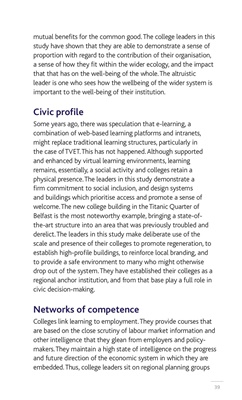
39
mutual benefits for the common good. The college leaders in this
study have shown that they are able to demonstrate a sense of
proportion with regard to the contribution of their organisation,
a sense of how they fit within the wider ecology, and the impact
that that has on the well-being of the whole. The altruistic
leader is one who sees how the wellbeing of the wider system is
important to the well-being of their institution.
Civic profile
Some years ago, there was speculation that e-learning, a
combination of web-based learning platforms and intranets,
might replace traditional learning structures, particularly in
the case of TVET. This has not happened. Although supported
and enhanced by virtual learning environments, learning
remains, essentially, a social activity and colleges retain a
physical presence. The leaders in this study demonstrate a
firm commitment to social inclusion, and design systems
and buildings which prioritise access and promote a sense of
welcome. The new college building in the Titanic Quarter of
Belfast is the most noteworthy example, bringing a state-ofthe-art
structure into an area that was previously troubled and
derelict. The leaders in this study make deliberate use of the
scale and presence of their colleges to promote regeneration, to
establish high-profile buildings, to reinforce local branding, and
to provide a safe environment to many who might otherwise
drop out of the system. They have established their colleges as a
regional anchor institution, and from that base play a full role in
civic decision-making.
Networks of competence
Colleges link learning to employment. They provide courses that
are based on the close scrutiny of labour market information and
other intelligence that they glean from employers and policymakers.
They maintain a high state of intelligence on the progress
and future direction of the economic system in which they are
embedded. Thus, college leaders sit on regional planning groups